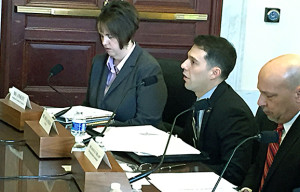 Recently, VetsFirst Director Ross Meglathery testified before the House Committee on Veterans’ Affairs’ Subcommittee on Economic Opportunity regarding the VA’s Loan Guaranty and specifically Adaptive Housing (SAH) Grant Programs.
Recently, VetsFirst Director Ross Meglathery testified before the House Committee on Veterans’ Affairs’ Subcommittee on Economic Opportunity regarding the VA’s Loan Guaranty and specifically Adaptive Housing (SAH) Grant Programs.
In his opening remarks, Meglathery said that VetsFirst wholeheartedly backs the SAH Program because “the ability to own a home that is adapted to the unique needs of each individual is critical for both the emotional and physical well-being of the veteran.” He went on to highlight areas for improvement to make the program more successful.
Meglathery pointed out that having both the SAH and the Vocational Rehabilitation & Employment Program (VR&E) performing housing modifications for veterans was an inefficient way to utilize limited resources. Meglathery, who previously testified that the VR&E is overworked with large caseloads supporting vocational rehabilitation, praised the VR&E staff for its hard work and diligence but added that their expertise is not in home modification, which is the strength of the SAH staff.
“By taking home modification off their portfolio,” Meglathery said, “the VR&E would be able to focus on their areas of expertise.”
Meglathery did say that VetsFirst opposed removing VR&E from the process altogether. If the veteran is getting vocational rehabilitation in conjunction with home modification, he recommended a three-way dialogue between the veteran, SAH and VR&E.
Meglathery added that VetsFirst would like to have SAH fully funded given an increase in approved grants and the addition of the VR&E’s caseload. He argued that, in the long term, taxpayers would see cost savings by removing the stovepipe of two parallel programs.
In terms of the actual SAH benefit, Meglathery stated that VetsFirst believes it is too low. The maximum amount of a SAH grant is $73,768. Meglathery argued that this amount is insufficient in areas with a high cost of living, forcing the veteran to make tough choices as to what to modify or to pay the remainder out-of-pocket. He pointed out a need for the benefit to be based on the local cost of living rather than a standard, across-the-board amount.
“As anyone in the National Capital Region is aware, the cost of living in Washington DC, for instance, is not the same as it is in Boise, Idaho,” Meglathery said.
Meglathery also pointed out that the SAH grant process seems to take longer than desired, based on feedback from his lead veterans service officer and veterans that used the Ask VetsFirst helpdesk. He suggested that this feedback provides an opportunity to find a solution for more rapid responses.
Meglathery concluded his remarks by praising the VA’s Loan Guaranty Program, which helps veterans finance the purchase of homes with favorable loan terms and at an interest rate which is usually lower than the rate charged on other types of mortgage loans. More than 80% of veterans use the program because of its affordability and ease of use, and the delinquency rate for this program is quite low due to “the holistic approach to ascertaining the veteran’s income based on monthly expenses.”
As a user of the program, Meglathery pointed out that, in a period in which the VA has had much criticism leveled at it, “the Loan Guaranty program is an example of the VA doing right by veterans.”
